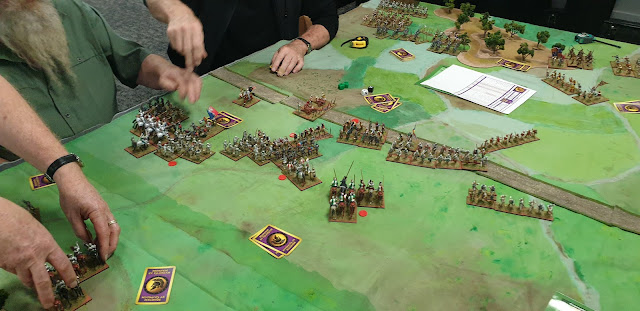Chris & I are spending a week in Canberra with our primary mission being as FIFO workers building a shed & carport for SteveD. Today heavy rain made work on the project impossible, but conveniently it was Sunday so Steve & Dale could take us to a local wargamers meeting. The informal wargaming club have an arrangement with a leagues club. On Wednesday nights & Sunday afternoons they have free use of huge room, with a bar & restaurant laid on. There were about 50 wargamers there playing a variety of wargames, including Wings of War, WWII naval, 6mm Napoleonic, WWII both 28mm & 15mm, board games & 100 Years War 28mm.
Dale set up a 100 Years War game with 28mm figs using Mortem et Glorlam rules.
Dale & Jim with French v. SteveD & Chris with English.
Each dice colour having a different number of each of a set of symbols, a deaths head = 1 stand killed, crossed swords = 1 wound (2 wounds = 1 kill), S (only counts in certain circs) or blank. So the best dice, the red, had more deaths heads & the black dice the least. So the difference in combat value of opposed troops determined which colour dice they used. Units break on exceeding 50% casualties.
The cards were similarly coloured with black cards being pretty useless & red best. Each turn, cards were dealt out for each general, 4 for best generals, 3 for average ones & 2 for dummies. There is a complex table of what each type of unit can do if a certain card is played. For instance, a red card might allow a drilled unit to make a double move plus a wheel, but a less well trained unit only allows a double move straight ahead.
The turn sequence goes:
1. Deal out a new set of cards.
2. Charge & immediately resolve 1st impact combat.
3. Shoot.
4. Move.
5. HTH combat (including another round of the new charges.
In the movement phase the players take turns to select a units or group of units under the same commander & move them subject to having the appropriate card to play.
The French are advancing on their left with mounted & dismounted knights.The English sent their knights to strengthen their right & are advancing their own left.The French attack of dismounted knights has broken the English billmen on the right flank & the French are wrapping around the English left. The English knights sent to the support their right have been met with French reserve cavalry.The English counterattack with bowmen & some men at arms v. crossbowmen in the centre also had some success.
The far flank in a sideshow of lighter forces.The French gained the initiative & their attack was led by their best attacking troops, while the English counterattack was made by troops better suited for defense. As a result the French attack was more effective & the English broke before their counterattack could do enough damage to effect the French.
I enjoy trying new rules, you never know wheren you might pick up a good idea. That the best strategy wins is a good sign for a set of rules, but I found nothing worth adopting into our own rules in these rules. The combat system provided too few ways for skill to influence results. The use of different coloured dice seemed more like a way of being different than a means of making combats easy to resolve. And I seriously dislike being dictated to by cards. Real generals don't examine a deal of cards & select the best option available. They decide what is their best option & issue orders with the knowledge that it might not happen. Our rules' system of requiring a test to activate orders replicates that.






No comments:
Post a Comment